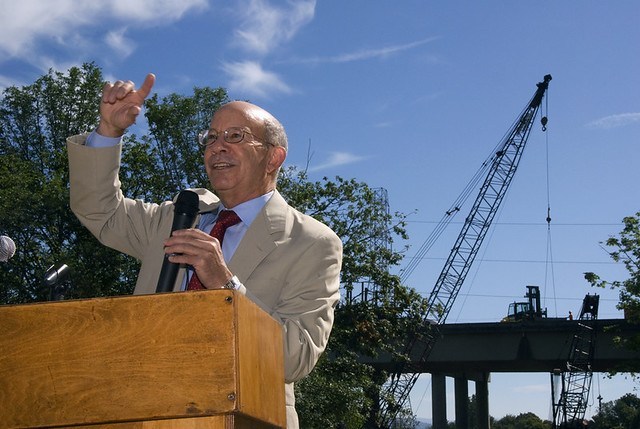Coord invites cities and other curb managers to apply for its Digital Curb Challenge to undertake a free curb management pilot program in 2020. Applications close on Feb. 14. Click here for information.
Go green or go home.
The $760-billion infrastructure package released by House Democrats on Wednesday would shift America towards more sustainable transportation and away from endless highway construction. It may never become law — indeed, the package is neither "concrete [nor] politically palatable, as Politico sniffed — but it's encouraging to see someone prioritizing non-automotive transportation. Here are the highlights:
The Good:
- A strong focus on ending climate change: Did you know that states aren't currently required to even measure their annual greenhouse gas output, much less take steps to reduce those numbers? The new House plan would instead mandate that "states [develop] policies and mak[e] investments that will reduce transportation-sector pollution." To help, the House specifically mandates a "boost in investment in cycling, walking, and public transportation" as a carbon-reducing strategy. That's a crucial distinction that will prevent states from hyper-focusing on electric and hybrid vehicle technology at the expense of sustainable transportation programs that would get cars off the road — and make our streets safer in the process.
- Roadway safety initiatives with real teeth. As Streetsblog has been reporting, our current laissez-faire process of letting states self-determine their safety "targets" for roadway fatalities is a travesty — not least because one-third of them set "goals" that wouldn't reduce deaths at all. The Dems' plan would modify the program to hold states accountable, and specifically called for improvement in the realm of pedestrian and cyclist safety. The framework would also require requires states and cities to use Complete Streets standards and policies.
- Freight without trucks. Fun fact: 80 percent of U.S. communities get their goods exclusively by truck, according to the American Trucking Association. That's a stat that, for generations, has been used to justify putting truck-sized style roads in urban areas — and the relationship between mega-roads and high driver speeds that kill is well documented. The Dems would invest more in getting goods to market by other modes, which opens up the possibility for road diets in more places.
- A potential shift to a Vehicle Miles Traveled tax. As cars get more and more fuel efficient (a good thing!), our frozen-in-time federal gas tax becomes less and less able to fund our transportation needs — especially the sectors that need the largest investments, like rail. Switching to a distance-based tax could be a game changer for the environment, and a serious incentive for Americans to drive a little less rather than simply buy fuel-efficient vehicles (which we should be requiring them to do anyway). Democrats would fund a national pilot program that could make that shift possible.
- Trains, trains, trains... Seriously, this framework is really into trains. Fifty-five billion dollars of the package is devoted to improving rail, with a strong emphasis on passenger service. “These transportation priorities reflect 21st-century needs, and we are enthusiastic about how the ‘Moving Forward Framework’ will shape the future of transportation spending," said Kevin Mills, the vice president of policy for the Rails-to-Trails Conservancy, an open-space advocacy group.
- ...and buses! The Democrats' framework points out that federal funding for improved bus system has been cut in recent years — and it commits to restore and expand it, though it doesn't say by precisely how much. Still, that's a heartening inclusion, considering the fact that in US communities with no or limited public transportation, a bus is a far more sensible and effective first-step option than a full-on train network.
- Not just more transit — more useful transit. It's one thing if the federal government gives your city money to build a light rail line. It's another thing if the resulting line doesn't connect the residents who need public transportation most with the jobs and services they need. The Dems' plan requires recipients of federal funds "to prioritize transportation access and to consider during the planning process all system users, job access, connections to housing, and creation of transportation options in underserved communities."
But there are a few programs in the framework that need our attention. Here's a few areas to watch as the framework becomes a formal bill:
- Fix it first. Sick of communities building endless roadways without fixing the ones they've got? We are, too. The Democrats say they'll prioritize maintenance over new construction — though it remains to be seen whether they'll actually deny states new road funding if those states fail to adequately address maintenance. Guess we'll see.
- Equitable congestion controls. The framework plans to "institute tighter standards around tolling and congestion pricing" in the name of equity, but doesn't say how the Democrats propose to do that. But here's the trick: though tolls tend to disproportionately impact the poor, so does our current road funding system, to about the same degree. So when progressives talk about making tolls fair, it sounds great — except all too often, equity arguments against variable pricing are misused to maintain the status quo and justify continued subsidies to drivers of all economic classes. It'd be nice to know exactly what the Democrats mean here, but the language in the bill is brief.
- Autonomous Vehicles. Transportation safety advocates are divided on whether AVs are the answer to pedestrians' prayers, or just another way to justify more cars on the road — and further reinforce a road hierarchy that puts automobiles above everyone. So you might be thrilled that the Democrats are committing to fund research programs for "infrastructure changes needed to accommodate autonomous vehicles" — or you might be skeptical. After all, supporters of driverless cars are already talking about gates on roadways to prevent pedestrians from crossing wherever they want because they know the cars will stop for them.






